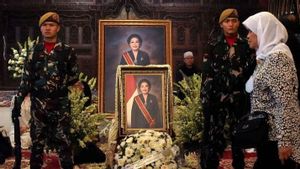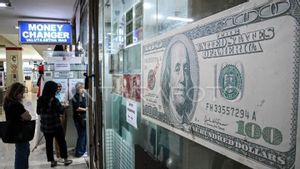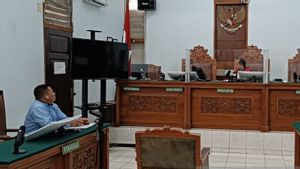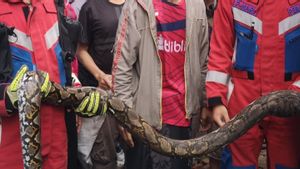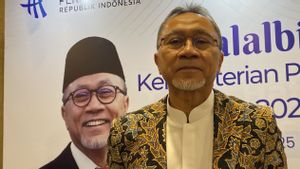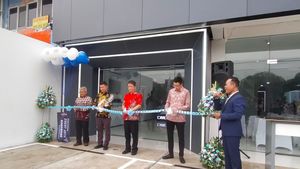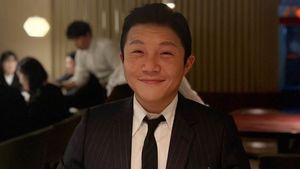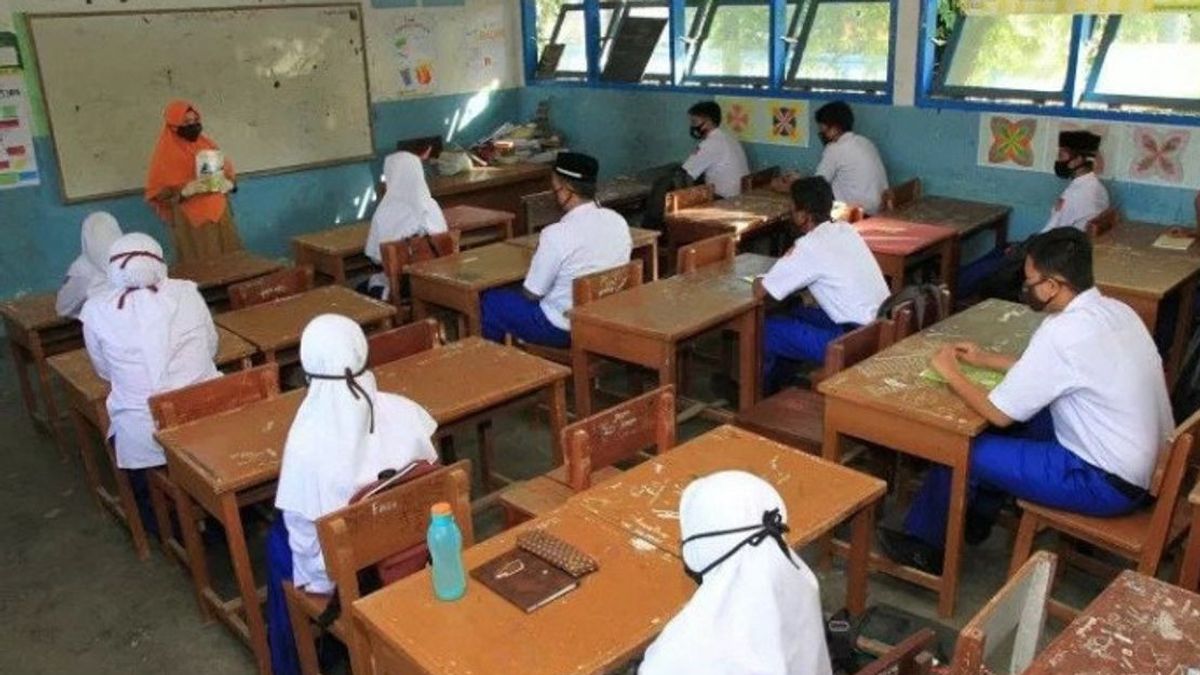
JAKARTA - The Ministry of Education, Culture, Research and Technology (Kemendikbud Ristek) has reopened schools. Face-to-face learning (PTM) is limited in the PPKM Level 3 period starting today. Of course health and safety is everything. But it's also not right to let this country experience a learning loss, which eventually leads to the breaking of the line of the educated generation.
Today, 610 schools from PAUD, SD, SMP, SMA, SMK, MTs, MA, to MI levels in DKI Jakarta held limited face-to-face learning (PTM) during PPKM Level 3. In detail, 85 schools have held PTM trials since 7 Last April, 138 schools on June 9 last, and an additional 372 new schools will join PTM today.
The number of 610 schools was determined after participating in an assessment of the readiness to open a limited PTM in their respective education units. Education units participating in limited PTM must carry out procedures in accordance with the Joint Decree of the Minister of Education and Culture, Research and Technology Number 03/KB/2021, Minister of Religion Number 384 of 2021, Minister of Health Number HK 01.08/Menkes/4242/2021, and Minister of Home Affairs Number 440-7171 of 2021 about the Implementation of Learning in the Time of the COVID-19 Pandemic.
In addition, the DKI Provincial Government has also issued a Decree from the Head of the DKI Education Office Number 882 of 2021. In the decree, it is explained that the method of implementing learning is through blended learning, namely learning in class and learning online. Check out the full rules through the ACTUAL article entitled Jakarta School Holds Face-to-face, Here's the Complete Rules.
In limited PTM, the education unit forms a COVID-19 Task Force team and coordinates with the puskesmas and village COVID-19 Task Force to ensure the readiness of the PTM. The kelurahan/sub-district Satpol PP are also involved to ensure students comply with the implementation of health protocols from leaving to school.
In the regulations, schools are also required to have sanitation and hygiene facilities, such as toilets and hand washing facilities. Schools must have access to affordable health care facilities. Everyone in the school is required to wear a mask. Equally important, schools must provide firing temperature gauges.

Then, the school mapped everyone who was not allowed to participate in PTM, who had comorbid students, did not have access to transportation that allowed social distancing, had a travel history for each zone (yellow, orange, and red) or a history of contact with positive confirmed people who had not yet been identified. completed 14 days of self-isolation.
When implementing PTM, parents or guardians of students are not allowed to wait at school. Parents are asked to always remind their children to always apply health protocols and inform the school if their child has ever suffered from serious illness or has been hospitalized. Limited PTM can be stopped at schools if there are positive cases of COVID-19, violations of regulations or changes in the COVID-19 situation.
In East Java, there are 2,536 schools from SMA/SMK to SLB that are starting limited PTM today. Governor Khofifah Indarparawansa who monitors the implementation of PTM at SMK Negeri 7 Surabaya said the opening of schools will be carried out in stages. Khofifah also detailed that the 2,536 schools came from 20 districts/cities, all of which were categorized as level 3 PPKM.
"Today is the last day of PPKM level 4 throughout Indonesia, and it will be evaluated this afternoon. If there is an evaluation, we will re-evaluate it," said Khofifah, Monday, August 30.
As Khofifah explained, the policy will be dynamic. It all depends on the pandemic situation in each zone. DKI Jakarta itself targets to open 1,500 schools by mid-September. Along with that, 3T strategies (testing, tracing, treatment) and 5M (wearing masks, washing hands, maintaining distance, avoiding crowds, and reducing mobility.
"Gradually, we will increase the number of schools that will implement limited PTM, starting in mid-September. It will collect data so that it becomes 1500 schools ... That's part of our gradual efforts so that schools in DKI can implement limited PTM as a whole," said Taga when met in the East Jakarta area, Monday, August 30.
What's wrong with online learning and why face-to-face?Thursday, August 12, the Director General of Early Childhood Education, Primary and Secondary Education (Dirjen PAUD Dikdasmen) of the Ministry of Education and Culture, Ristek Jumeri, explained the evaluation of educational activities during the pandemic that swept the world and Indonesia. According to him, problems with quotas, internet access, and even distribution of ownership of gadgets are still the main obstacles.
"Most of those online are in urban areas. There are also many obstacles going forward, including not all of them have learning tools, do not have data credit, and not all areas have good internet access. Then there are also limitations from our teachers," said Jumeri.
It is feared that this could exacerbate the situation of learning loss, which eventually led to the breakup of the educated generation in a civilization. There are long-term losses from learning losses. The uneducated generation will have low competence. This will cause the generation to be unappreciated. And it affects the world economy.
“Losses internationally will be up to IDR 10 trillion dollars. This is an extraordinary amount if the learning loss is maintained," said Jumeri.
And basically PJJ cannot replace PTM. Education observer, Doni Koesoema said the ideal education policy during a pandemic is a realistic policy. And the student's learning experience must be an orientation in policy formation. So, when PJJ is unable to fulfill the student's learning experience, PTM must be an option.

Doni saw some unavoidable problems in the implementation of PJJ so far. These problems make many children lose the learning experience. Many technical obstacles in the form of the availability of gadgets, internet access, to problems with other facilities and infrastructure.
“So under any circumstances the government must focus on providing learning rights for students according to their conditions. What I call the ideal policy is the realistic one,” said Doni, contacted by VOI.
Furthermore, Doni explained the principal aspects in PTM that could not be replaced by PJJ. First, a more personal greeting and attention. Second, losing touch on the real conditions experienced by teachers and students. Third, the obstacle for teachers to give full educational content to students. The simplest in terms of questions and answers, for example.
"So that's what then disappeared. So the personal relationship and social attention are the relationship between teachers and students in direct learning. Whereas direct feedback is a way to improve the quality of learning outcomes. If PJJ is feedback, it can't be done directly, "said Doni.
Epidemiologist at Griffith University, Australia, Dicky Budiman said that the position and function of schools was unique during the pandemic. There is a global agreement pushing for standard procedures for schools to be the first sector to open when the pandemic situation improves and the last to close when the outbreak worsens. The agreement, said Dicky, was based on scientific arguments.
A pandemic basically cannot kill aspects of human life. Efforts to control transmission must be accompanied by the formation of strategies on how to return life to the most normal level that can be achieved. In terms of education, it is as important to protect students as it is to ensure that their learning rights are fulfilled.
“That school is not only for children to learn but there is a big impact. Big impact for the child, big impact for this country. One nation. This is not just a health problem. There is also the problem of the existence of a nation in future generations. That is why the issue of enforcing school openings is a very important priority,” Dicky told VOI.
“Even in a very limited epidemic situation a hundred years ago, this condition has been enforced so that children are still in school, even outdoors. And that is indeed in accordance with the pandemic strategy in the majority of countries that it is now possible to start opening schools. Of course there is a safety net. So if there are those who think that schools should close, other than that, they are misguided, it is not in accordance with scientific arguments,” added Dicky.
What is learning loss? Are there any other negatives to online learning?Of course health and safety is everything. But it's also not right to let this country experience a learning loss, which eventually leads to the breaking of the line of the educated generation. Like it or not, the threat is real.
A UNICEF research in 2020 described the shattered situation of education in the world. Learning loss is the main threat that UNICEF focuses on. In early April 2020 or a month after COVID-19 was declared a pandemic, 91 percent of the world's schools were closed.
That percentage then decreased to 61 percent in July 2020. The decline is the impact of many countries starting to adapt local restrictions per region rather than closing the whole country.
In this dynamic situation, UNICEF immediately gave a call to many countries to prioritize the reopening of schools when the situation is safe. Authorities are asked to be literate and responsive.
In Indonesia, Lentera Anak's research revealed that children who are most vulnerable to learning loss are those who do not have maximum access to online learning. Children in rural and remote areas, for example.
Another factor is parents who have a low level of education. They are more difficult to understand the distance learning style with all the technical problems. Research also reveals that so many children are bored with online learning.
In addition, many parents admit that they are overwhelmed with limitations to continuously accompany their children to learn. They also have job demands. Meanwhile, teachers are required to continue to innovate. A difficulty if it is personally charged to the teacher.
In addition to suboptimal learning that leads to learning loss, Lentera Anak also catches another problem in children during distance learning: mental health. This is generally related to the deteriorating state of the relationship between the parents of the children.
Not a few are affected by economic problems, such as reduced income and even layoffs. Not a few children are also affected by violence due to parents who are not ready to face financial conditions as a result of the pandemic.
*Read other information about COVID-19 or read other interesting articles from Yudhistira Mahabharata.
Other BERNASThe English, Chinese, Japanese, Arabic, and French versions are automatically generated by the AI. So there may still be inaccuracies in translating, please always see Indonesian as our main language. (system supported by DigitalSiber.id)


